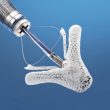Permanent pacemaker implantation (PPI) is a relevant complication in patients undergoing transcatheter aortic valve replacement (TAVR) despite there being new devices. The current information on the long term impact of this complication remains unclear and recent evidence suggests post-TAVR ventricular pacing (VP) might be associated to higher risk of all-cause mortality and hospitalization for cardiac<a href="https://solaci.org/en/2023/05/28/impact-of-right-ventricular-pacing-in-patients-with-permanent-pacemaker-implantation-after-tavr/" title="Read more" >...</a>
Latest Developments in Tricuspid Regurgitation
The natural history of tricuspid regurgitation is associated to hospitalization for cardiac failure and mortality. This is why the AHA/ACC guidelines recommend surgery when the tricuspid fails during left valve surgical repair, because its slow progression is associated with high mortality (35%). Many of these patients are high risk and percutaneous intervention has surged as<a href="https://solaci.org/en/2023/05/12/latest-developments-in-tricuspid-regurgitation/" title="Read more" >...</a>
When Is It Best to Fracture a Bioprosthesis in TAVR?
At present, surgical aortic valve replacement (SAVR) uses bioprostheses. However, when these fail, we are presented with a great challenge, seeing as repeat SAVR involves a higher risk. In this context, valve-in-valve (V-in-V TAVR) has surged as a very attractive alternative. Bioprosthesis fracture (BPF) is a new interesting strategy that has shown lower gradient and<a href="https://solaci.org/en/2023/03/28/when-is-it-best-to-fracture-a-bioprosthesis-in-tavr/" title="Read more" >...</a>
COAPT: Promising 5-Year Outcomes
Secondary ischemic and non-ischemic mitral valve failure (SMR), produce left ventricle dilation, papillary muscle displacement, and impaired leaflet closure causing regurgitation. This will lead to ventricular function deterioration and bad prognosis. Edge-to-edge mitral valve repair with MitraClip has been shown safe and effective to treat SMR in the short term, but its evolution at 5<a href="https://solaci.org/en/2023/03/17/coapt-promising-5-year-outcomes/" title="Read more" >...</a>
Mechanical Aspiration in ST Elevation ACS
In ST elevation ACS the preferred treatment is primary PCI. However, one its limitations is thrombus presence and its distal embolization, which threatens microcirculation perfusion and is therefore associated to ventricular function deterioration and bad evolution. Manual thrombus aspiration has been tested in different studies but the problem remains unsolved; mechanical thrombectomy might be a<a href="https://solaci.org/en/2023/03/10/mechanical-aspiration-in-st-elevation-acs/" title="Read more" >...</a>
ACC 2023 | COAPT Study: 5 Year Followup after Transcatheter Repair of Secondary Mitral Regurgitation
The five year outcomes of the multicenter open label COAPT (Cardiovascular Outcomes Assessment of the MitraClip Percutaneous Therapy for Heart Failure Patients with Functional Mitral Regurgitation) were presented at ACC 2023; it included 614 patients with cardiac failure (CF) and moderate to severe (3+/4+) symptomatic secondary mitral regurgitation, despite medical therapy. Patients were randomized 1:1<a href="https://solaci.org/en/2023/03/07/acc-2023-coapt-study-5-year-followup-after-transcatheter-repair-of-secondary-mitral-regurgitation/" title="Read more" >...</a>
Uncomplicated Type B Aortic Dissection
Mortality Assessment, Interventions and Hospitalization in Patients with Uncomplicated Type B Aortic Dissection with TEVAR. Over 60% of type b aortic dissections present with no complications, such as signs of imminent rupture or already established poor perfusion. Most uncomplicated type b aortic dissections (uTBAD) are managed with medical treatment to control pain and limit the<a href="https://solaci.org/en/2023/02/08/uncomplicated-type-b-aortic-dissection/" title="Read more" >...</a>
The most read articles of january in solaci.org
These were the most read articles of interventional cardiology in solaci.org. Real-World Revascularization Strategy for Left Main Coronary Artery: Surgery or PCI? There are many current randomized trials comparing percutaneous coronary intervention (PCI) with myocardial revascularization surgery (MRS) for the treatment of left main coronary artery disease (LMCAD). Real-World Results of Different Devices for TAVR Transcatheter aortic valve replacement (TAVR) keeps<a href="https://solaci.org/en/2023/02/06/the-most-read-articles-of-january-in-solaci-org/" title="Read more" >...</a>
Resistant Obstructive Hypertrophic Cardiomyopathy: Myomectomy or Septal Ablation?
Approximately 70% of hypertrophic cardiomyopathies (HCM) are associated to a left ventricular outflow tract (LVOT) obstruction and mitral valve failure leading to dyspnea and cardiac failure in a high number of patients. Even though at present there are effective drug treatments combined with pacemaker implantation, surgery (septal myomectomy (SM) continues to be the first choice<a href="https://solaci.org/en/2023/01/25/resistant-obstructive-hypertrophic-cardiomyopathy-myomectomy-or-septal-ablation/" title="Read more" >...</a>
Non-ST Elevation MI: How Long Do We Have for A Coronary Angiography?
This summary discusses the early invasive strategy and the risk of mortality in non-ST-elevation AMI. Over the past 2 decades, mortality and complications rates have seen a significant reduction thanks to technological and pharmaceutical development, and the increasing experience of health teams. This is especially true when we look at the use of coronary angiography<a href="https://solaci.org/en/2023/01/20/non-st-elevation-mi-how-long-do-we-have-for-a-coronary-angiography/" title="Read more" >...</a>









